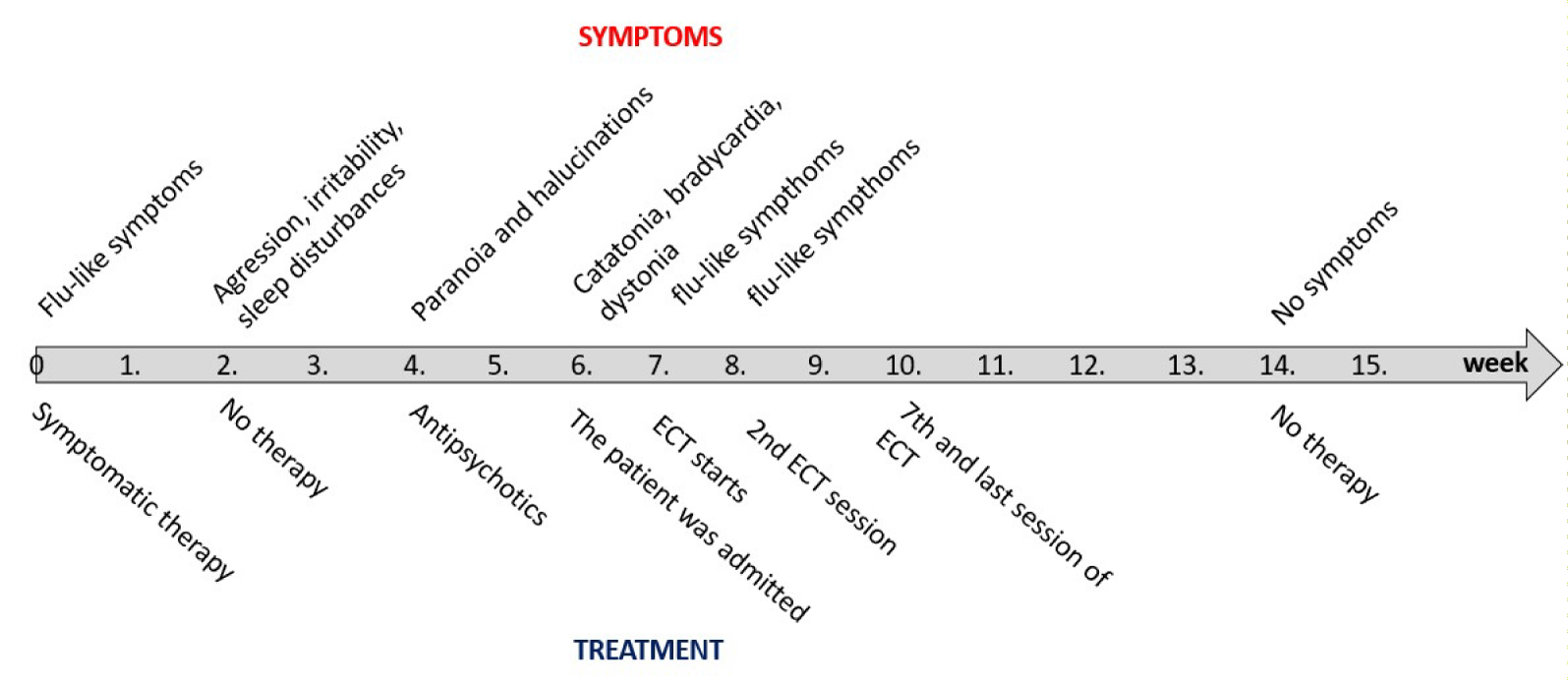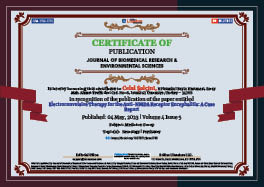Medicine Group . 2023 May 04;4(5):853-855. doi: 10.37871/jbres1743.
Electroconvulsive Therapy for the Anti-NMDA Receptor Encephalitis: A Case Report
Celal Salcini*, Ahmet Yosmaoglu, Nevzat Tarhan and Oguz Tanridag
- Electroconvulsive therapy
- Anti-NMDA encephalitis
- Psychosis
- Dystonia
- Encephalitis
Abstract
Anti-NMDA encephalitis is a rare autoimmune disorder that affects the central nervous system. We report a case of a 22-year-old male patient with a history of prodromal flu-like symptoms followed by brief aggression episodes, paranoid symptoms, and stereotypic movements. Routine blood work, a brain MRI, and an EEG were normal. Cerebrospinal Fluid (CSF) studies show no abnormality, and the neuronal antibody panel was administered. Antipsychotics and benzodiazepines did not have any benefits, and Electroconvulsive Treatment (ECT) was recommended for the ongoing symptoms of catatonia. Movement disorders and cognition gradually improved after the second session of ECT. Later, CSF study results demonstrated the presence of anti-NMDA antibodies, and standard therapy was administered. Our case suggests that ECT may be an effective treatment option for patients with anti-NMDA encephalitis. Further studies are needed to confirm the efficacy and safety of ECT in this patient population.
Introduction
Anti-NMDA encephalitis is a rare autoimmune disorder characterized by the presence of antibodies against the N-Methyl-D-Aspartate (NMDA) receptor in the central nervous system. The disorder predominantly affects young adults, often accompanied by a wide range of neurological and psychological symptoms, including movement disorders, hallucinations, and delusions. The diagnosis of anti-NMDA encephalitis is based on clinical presentation, Cerebrospinal Fluid (CSF) analysis, and the detection of anti-NMDA receptor antibodies in the serum or CSF. The treatment of anti-NMDA encephalitis should be individualized and typically involves high-dose corticosteroids, İntravenous İmmunoglobulin (IVIG), plasmapheresis, immunosuppressive medications, and tumor resection when indicated. However, some patients may not respond to these treatments, and alternative therapies may be necessary.
Case Report
We report a case of a 22-year-old man with anti-NMDA receptor encephalitis that is treated with Electroconvulsive Therapy (ECT). The patient had prodromal flu-like symptoms that was treated by symptomatic medication and had no history of any other disease. Firstly, he had brief aggression episodes, irritability, and sleep disturbances, followed by normal behavioral periods that continued for a day or two. After a few weeks the patient developed paranoid symptoms, visual and auditory hallucinations. He was treated as outpatient antipsychotics with no clear benefit and admitted to a psychiatry clinic. Neurological examination revealed routine work, brain MRI and EEG were normal. His situation aggravated, and he developed bradycardia, catatonia like symptoms, and episodes of dystonic posture and chorea-like movements of limbs for the last 2 weeks, a “pill rolling” stereotype behaviour. CSF studies showed no abnormality, and the neuronal antibody panel was administered. Antipsychotics and benzodiazepines did not have benefits, and ECT was recommended for the ongoing symptoms of catatonia [1]. Movement disorders and cognition gradually improved after the second session of ECT. The patient was given a total of seven ECT sessions over the course of 20 days, with a frequency of three sessions per week. The patient showed normalization after the ECT treatment. Screening for abdominal and scrotal neoplasms using ultrasound was negative. Later, CSF study results demonstrated the presence of anti-NMDAR antibodies, and standard therapy was administered in a different medical center, due to insurance protocols. No further treatment was applied, as it was not clinically necessary.
Discussion
Anti-NMDA encephalitis is an uncommon but potentially life-threatening disorder that requires prompt diagnosis and treatment. Anti-NMDA encephalitis is often treated with high-dose corticosteroids and immunosuppressive medications. However, some patients may not respond to these treatments, and alternative therapies may be necessary. Our case report demonstrates that ECT may be an effective treatment option for patients with anti-NMDA encephalitis who do not respond to conventional therapies.
The use of ECT in the treatment of anti-NMDA encephalitis is supported by a small number of case reports. There is published systematic review about ECT and anti-NMDA encephalitis cases, that presents a patient with anti-NMDA encephalitis who did not respond to IVIG and corticosteroids and showed significant improvement after getting ECT [2]. There are similar case reports, and those cases received ECT prior to a definite diagnosis of anti-NMDA receptor encephalitis because of laboratory delay of antibody testing. Also, ECT is effective in cases with catatonia and refractory psychiatric symptoms, which carry severe consequences of long-term immobility.
The mechanism of action of ECT in the treatment of anti-NMDA encephalitis is unclear. ECT may have an immunomodulatory impact. It has been shown that ECT is associated with rapid induction of inflammatory cytokines most likely in the central nervous system, which may modulate the immune response in patients with autoimmune illnesses [3].
Another possible explanation for the effectiveness of ECT is its complex impact on synaptic plasticity. The NMDA receptor, as well as glutamate, GABA and dopaminergic neurotransmitters play a key role in synaptic plasticity. Dysregulation of this receptor function by the anti-NMDA receptor antibodies may contribute to the neurological and psychiatric symptoms seen in patients with anti-NMDA encephalitis [4].
Despite the potential benefits of ECT in the treatment of anti-NMDA encephalitis, there are also potential risks and side effects associated with this treatment. These include cognitive side effects such as memory loss, confusion, and disorientation, as well as physical side effects such as headache, nausea, and muscle soreness. However, in our case, the patient did not experience any significant cognitive or physical side effects from the ECT treatment (Figure 1).
Conclusion
Our case report suggests that ECT may be a promising treatment option for patients with anti-NMDA encephalitis who do not respond to conventional therapies. Further studies are needed to confirm the efficacy and safety of ECT in this patient population and to better understand its mechanism of action. Given the potential risks and side effects of ECT, it should be reserved for cases where other treatments have failed or the patient's condition is rapidly deteriorating.
Author Contributions
Celal Salcini, drafting/revising the manuscipt and accepts responsibility for conduct of research and final approval.
Ahmet Yosmaoglu, revising the manuscipt and accepts responsibility for conduct of research and final approval.
Nevzat Tarhan, critical revision of manuscript for intellectual content and accepts responsibility for conduct of research and final approval.
Oguz Tanridag, critical revision of manuscript for intellectual content nd accepts responsibility for conduct of research and final approval.
Author disclosures
The authors report no disclosures relevant to the manuscript.
References
- Coffey MJ, Cooper JJ. Electroconvulsive Therapy in Anti-N-Methyl-D-Aspartate Receptor Encephalitis: A Case Report and Review of the Literature. J ECT. 2016;32(4):225-9. Epub 2016/06/14. doi: 10.1097/YCT.0000000000000334. PubMed PMID: 27295461.
- Warren N, Grote V, O'Gorman C, Siskind D. Electroconvulsive therapy for anti-N-methyl-d-aspartate (NMDA) receptor encephalitis: A systematic review of cases. Brain Stimul. 2019;12(2):329-34. Epub 2018/12/12. doi: 10.1016/j.brs.2018.11.016. PubMed PMID: 30528383.
- Lehtimaki K, Keranen T, Huuhka M, Palmio J, Hurme M, Leinonen E, et al. Increase in plasma proinflammatory cytokines after electroconvulsive therapy in patients with depressive disorder. J ECT. 2008;24(1):88-91. Epub 2008/04/02. doi: 10.1097/YCT.0b013e3181571abb. PubMed PMID: 18379341.
- Pirnia T, Joshi SH, Leaver AM, Vasavada M, Njau S, Woods RP, et al. Electroconvulsive therapy and structural neuroplasticity in neocortical, limbic and paralimbic cortex. Transl Psychiatry. 2016;6(6):e832. Epub 2016/06/09. doi: 10.1038/tp.2016.102. PubMed PMID: 27271858; PubMed Central PMCID: PMCPMC4931600.
Content Alerts
SignUp to our
Content alerts.
 This work is licensed under a Creative Commons Attribution 4.0 International License.
This work is licensed under a Creative Commons Attribution 4.0 International License.









